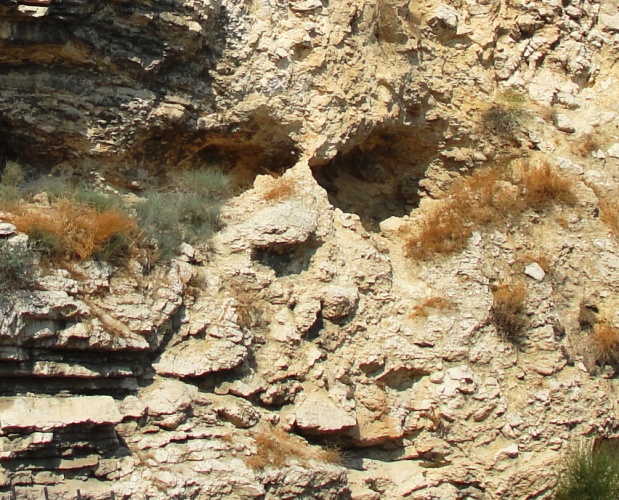Whose Skull Is Buried There?

Introduction
I blogged about the hyperlink between Psalm 22 and Jesus’s crucifixion, and also the connection between Psalms 23 and 24 with the resurrection this past Easter season. One question that came up during my studies was centered on the name of the location where Jesus’s crucifixion took place—Golgotha, Aramaic for the phrase, “the place of the skull” (Mat 27.33; Mar 15.22; Joh 17.17): Whose skull was it named after?
Scholars and theologians throughout church history offered four main explanations. According to Baker Encyclopedia of the Bible, there are four traditional explanations.[1]
However, the fact is we have no ideas what the answer is. In my attempt to tackle “the weird and the obscure stuff in the Bible”—my favorite pastime—I came up with a possible fifth option. Since no one can substantiate the previous four in absolute affirmative, in my opinion, mine is as good as any of them. But before I flesh out my hypothesis, I want to examine each of the four in detail to ensure mine has better biblical explanatory power.
Historical Explanation
A Skull-Shaped Hill
This is the most popular claim in the Church that posits Golgotha’s name came as the result of the crucifixion site was on a hill that resembles a skull (see below). However, no early evidence from any sources has been found to substantiate this view. Further, the Gospel accounts never referred to the place as a hill. Archaeologically speaking, we just do not have the precise location of Jesus’s crucifixion site to pin point that “Mount Golgotha” was the crucifixion site. Again, we can reject this view with confidence.
Common Place of Execution
According to history, this was the explanation originated with Jerome, an early fifth century church father (AD 346-420). He asserted Golgotha was a common disposal site for executed criminals. Because they were criminals, after their execution their skulls were strewn around the site. There are several reason I don’t accept this explanation. First, its grammar usage points to a singular skull, e.g., “a skull” (ESV) or “the skull” (CSB), not the plural “skulls”.
Second, though rare, Romans did practiced beheading, which was regarded as a more honorable means of execution and was only available to its citizens. The condemned would not experience suffering since beheading is relatively quick and painless. Church tradition teaches us Paul was executed in Rome in this manner, which makes sense since he was a Roman citizen.
But beheading wasn’t an option for criminals in Palestine. Roman public executions were generally events put on to execute runaway slaves, prisoners of war, common criminals and army deserters. They were used as deterrent and were great spectacles, a twisted form of entertainment. These executions were designed to inflict the maximum amount of pain for the longest possible time. The cruelest method of execution was the crucifixion. So it would seem odd to decapitate the corpse after the crucifixion.
Thirdly, since the fact that no first century evidence were found to substantiate Jerome’s claim, we can mark this explanation as unlikely true.
Symbol of Death
Some suggest that the name “skull” was used figuratively, simply as a symbol of death by execution. Again, there is no historical or biblical evidence to support this explanation.
Adam’s Skull
The last of the common explanation was based on the writing from another early church father, Origen (AD 185–253), who in his commentary on Matthew mentioned there is an early, pre-Christian tradition that the skull of Adam was buried in that place and hence its name. This is probably the oldest explanation on the origin of the name, and was used by several writers after Origen.
This legend [2]—in the spirit of Moses carrying Joseph’s bones back to the promised land for burial (Gen 50.25; Exo 13.19; Jos 24.32)—tells us that Noah brought Adam’s bones into the ark. Once the flood subsided, Noah divided Adam’s bones among his sons, and gave to Shem, his righteous son, the responsibility of taking Adam’s skull to Melchizedek, the king-high priest of Salem (Jerusalem), who then buried the skull outside the city. This place became known as “Karkaphta,” the place where Jesus was likely crucified.[3] Later, Jerome was credited by his contemporaries to have said Adam’s skull was buried under the very place Christ was crucified.[4]
Again, there is no biblical warrant for this view. Moreover, why would Adam want his skull to be buried in Salem, a place that was of no significance to him? The reason Joseph wanted his bones to be transported to Canaan was because he has a family tomb in Shechem (Jos 24.32). If Adam wanted to be buried anywhere specific, it would have been in Eden, near the garden’s entrance. I am skeptical of the historicity of this explanation. It’s legendary from the third century, nothing more.
An Alternate Explanation
There is a peculiar commentary in 1 Samuel 17 where the Scripture recorded the famous battle between David the shepherd boy and Goliath the Philistine giant. It was a story of a ultimate underdog defeating the undisputed champion. After David killed Goliath, he decapitated Goliath with his own sword. Anyone who has grown up in church has heard of this story in Sunday School. But what has been overlooked often is 1 Samuel 17.54:
And David took the head of the Philistine and brought it to Jerusalem, but he put his armor in his tent.
Remember, David served King Saul at this time, whose capital was at Gibeah, in the tribal territory of Benjamin. At that time Jerusalem still belonged to the Jebusites. It wasn’t until David became king and unified all twelve of Israel’s tribes in his seventh year of reign that he moved his capital from Hebron to Jerusalem (2Sa 5.5). So, the note in 1 Samuel 17.54 took place about 10 years after David’s victory over Goliath. And by the time he brought Goliath’s severed head to Jerusalem, it must’ve been only a skull.
Here is where I applied some sanctified inductive reasoning to the narrative. During the period of the judges and early monarchy, Israel’s main nemesis was the Philistines. Goliath was the epitome of the enemy of God’s people. While the Bible is silent as to where David put the Philistine’s head, I’m guessing his many wives weren’t too keen on having a giant skull on a wall of the palace. Furthermore, God’s enemies don’t belong inside his holy city. Thus, it’s entirely plausible Goliath’s head was buried outside of Zion.
So, I submit to you, it’s my hypothesis that Goliath’s head is that skull and its burial location became known as “The Place of the Skull”. This hypothesis has scriptural support, thus possesses superior explanatory power compared to ad hoc explanations and legendary tales. And this place was likely made into a “cursed” place, where the Romans continued the tradition of executing criminals there.
Was it still buried there at the time in the first century Palestine? Possibly, but no one knows. Herod had implemented significant reconstruction of Jerusalem and its surrounding area, and renovated the second temple. Is it still there today? Again, it’d be speculation but probably unlikely since the Romans destroyed Jerusalem and burnt down the temple in AD 70.
Theological Implication
One reason many Christian favor the Adam’s skull view is its theological implication—Jesus the second Adam has reversed the transgression of the first Adam. It’s a beautiful story of redemption. But I believe the Goliath skull hypothesis makes an equally, if not superior, theological importance.
We all know that David was Israel’s most famous king. And we all know that Goliath was his most notorious rival. Since Jesus is called the “son of David,” the promised eternal king of Israel, then we can make a parallel comparison between Goliath and Jesus’s nemesis (and ours): Satan. In John’s other book, Revelation, he refers to Satan as the “dragon… the ancient serpent” (Rev 20.2). This description should take us back to Genesis 3.14-15:
14 The LORD God said to the serpent,
“Because you have done this,
cursed are you above all livestock
and above all beasts of the field;
on your belly you shall go,
and dust you shall eat
all the days of your life.
15 I will put enmity between you and the woman,
and between your offspring and her offspring;
he shall bruise your head,
and you shall bruise his heel.”
The Hebrew shûwph for “bruise” (ESV) or “strike” (CSB) literally means to snap at; figuratively, it means to overwhelm or overcome. Theologians refer to the serpent’s condemnation as the “protevangelium,” the first glimmer of the gospel. It became clear to the Gospel writers that the crucifixion was the serpent “snapping at” the heel of the one who ultimately crushes his “head” upon his resurrection. A serpent’s poison is lodged in its head; and a “bruise” on that part is fatal. Thus, the fatal blow shall be the strike which Satan shall receive from Christ, though he didn’t understand the nature and extent of his doom at the time.[5] Paul understood the brilliance behind God’s plan which he hid from all the heavenly hosts from the very beginning. In 1 Corinthians 2.8 he explains:
None of the rulers of this age understood this, for if they had, they would not have crucified the Lord of glory.
The “ruler of this Age” are the principalities, authorities and power of darkness in the heavenly places (Eph 6.12). In other words, God permitted Satan to afflict the humanity of Christ. Satan thought he had thwarted God’s plan by killing the Messiah. Satan is smart enough to know that he could never defeat God Almighty. So he tries to do everything to delay his own judgment (cf Psa 82.6-7; Eze 28.2). However, had he realized this was God’s redemptive plan from the very beginning, he wouldn’t have done it.
Conclusion
As the blood of Jesus drips on the ground on “The Place of the Skull,” it was God fulfilling his promise to bruise or overwhelm the serpent’s “head”. The enemy has been neutralized. His power has been rendered impotent. The sin he ushered into the world by tempting Adam and Eve to disobey has been defeated, and its deadly consequence has been reversed because “it is finished! He has done it.” Jesus has defeated the tempter and the ensuing death. He completely finished his atoning work on the cross. There’s nothing else anyone can do to add to it. And the benefit we have is we can live in the freedom of Christ from today onward to eternity.
REFERENCES
[1] Carl Wayne Hensley, “Golgotha,” Baker Encyclopedia of the Bible (Grand Rapids, MI: Baker Book House, 1988), 890.
[2] Bar Bahluli apud Castel. Lexic. Polyglot. col. 3466; Elmacinus, p. 13. Patricides, p. 12. apud Hottinger. Smegma Oriental. l. 1. c. 8. p. 257; De Resurrectione Christi, p. 479.
[3] Elmacinus, p. 13. Patricides, p. 12. apud Hottinger. Smegma Oriental. l. 1. c. 8. p. 257.
[4] Epistle Marcellae, fol. 42. L. Tom. I.
[5] Robert Jamieson, A. R. Fausset, and David Brown, Commentary Critical and Explanatory on the Whole Bible, vol. 1 (Oak Harbor, WA: Logos Research Systems, Inc., 1997), 19.
